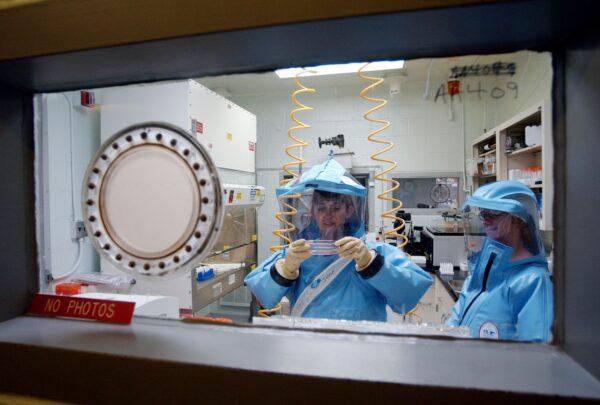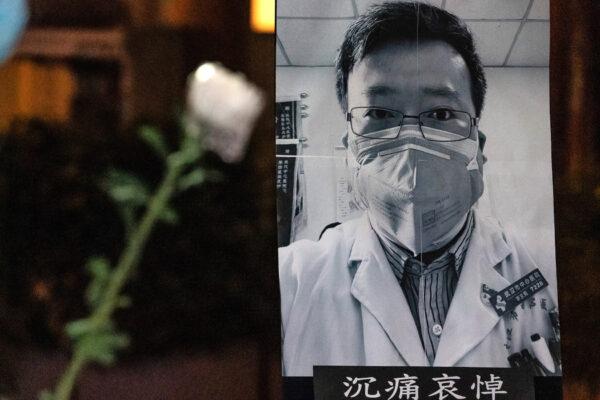A former U.S. Army microbiologist describes the report as a classic example of Beijing’s cognitive warfare waged against the United States.
News Analysis
Beijing’s latest white paper on COVID-19 didn’t just rehash propaganda—it took a step further.
Analysts say the Chinese Communist Party (CCP) resorted to its usual playbook of vitriol and lies, while revealing its biggest fear: being held liable for a pandemic that killed millions and upended the global economy.
The 23-page report titled “Covid‑19 Prevention, Control and Origins Tracing: China’s Actions and Stance” points to the United States as the origin of the SARS-CoV-2 virus that causes COVID-19, delivers veiled jabs at the Trump administration, and devotes a whole section refuting a court judgment that China owes the state of Missouri more than $24 billion for concealing pandemic data and hoarding protective equipment.
“If solid evidence ever proves that the virus originated from a state-backed lab in Wuhan, the CCP would be compelled to address many questions regarding its gain-of-function research, motives, the early cover-up, and why it allowed the pathogen to spread overseas,” Tang Jingyuan, a U.S.‑based China affairs analyst with a clinical medicine background, told The Epoch Times.
If the CCP acknowledged its failures in handling COVID-19, he said, “it would mean confessing to a crime against humanity.”
Beijing issued its white paper on April 30, less than two weeks after the White House launched the Covid.gov website, which suggests that the virus originated from a lab in Wuhan with “inadequate biosafety levels.”
Tang views the white paper as a preemptive strike in the larger U.S.–China tariff dispute. U.S. and Chinese trade officials held negotiations in Geneva on May 10–11, resulting in a 90-day trade truce in which both sides rolled back massive tariffs, providing time for further talks.
“Beijing assumes Washington might use the virus origin probe as a bargaining chip,” he said. “To neutralize that card, it moved early to muddy the waters.”
He compares the tactic to how Beijing manages the export of fentanyl precursors—deliberately creating a U.S. national security crisis that could later be leveraged for concessions.
Sean Lin, a former U.S. Army microbiologist, describes the report as a classic example of the CCP’s cognitive warfare—strategies aimed at obscuring the truth, shifting blame to Washington, and avoiding accountability.
US Origin Claim
In the white paper, the CCP revives an unfounded theory that the virus leaked from a U.S. Army laboratory at Fort Detrick, Maryland, according to Lin, also a former lab director at the viral disease branch of the Walter Reed Army Institute of Research.
It points to the temporary shutdown of Fort Detrick Biological Laboratory in 2019, linking it to unexplained pneumonia cases in nearby Virginia and a national surge of severe respiratory illness that the Centers for Disease Control and Prevention attributed to e-cigarette and vaping use during that period.

The facility, home to the U.S. Army Medical Research Institute of Infectious Diseases, closed briefly in 2019 following inspections by the CDC. The lab reported that the shutdown order was issued because of ongoing infrastructure problems with wastewater decontamination. The CDC did not disclose the reason for the shutdown, citing national security concerns.
Beijing’s white paper also cites a study, published in the “Clinical Infectious Diseases” journal in November 2020, that found SARS‑CoV‑2‑positive antibodies in Red Cross blood samples collected in nine U.S. states between Dec. 13, 2019, and Jan. 17, 2020, claiming that the virus was circulating in the United States as early as December 2019.
Tang calls the maneuver a quintessential CCP tactic: “offense as defense” and “accusation in a mirror.”
The study’s authors, however, noted that the antibody tests could have picked up reactions to other common coronaviruses, not just SARS-CoV-2. Additionally, it was difficult to determine whether the potential SARS-CoV-2 infections were associated with community spread or travel. Thus, the results cannot confirm the CCP’s claims of early circulation of the virus in the United States.
Shifting Blame Abroad
Tang said that Beijing aims to avoid global scrutiny with its latest white paper by shifting the blame away from Wuhan and transforming the discussion on the virus origins into a geopolitical blame game that it believes it can control.
He pointed out that whenever foreign governments question Beijing’s transparency, Chinese state media float alternative virus origin stories tailored to those countries.
For example, when Italian authorities pressed China for more data on the outbreak, Chinese state media distorted an Italian doctor’s remarks to suggest the pandemic began in Italy in November 2019.
Chinese state media also promoted research published by international experts and foreign media that claimed that the virus originated in the Netherlands, France, Australia, India, Spain—“anywhere, basically, but Wuhan,” U.S. think tank Jamestown Foundation said in a February 2021 report.
Leaked CCP documents, obtained by the Chinese-language edition of The Epoch Times in 2020, suggest that an outbreak likely began in China months earlier than Beijing admits.
A Feb. 19, 2020, directive from a central investigative team ordered Wuhan hospitals to comb through records from Oct. 1 to Dec. 10, 2019, looking for unexplained fever cases, COVID‑style lung images, and pneumonia deaths of unknown cause.

What US Intelligence Says
The Covid.gov website, launched on April 18, cites intelligence findings detailed in a comprehensive December 2024 report by the House Select Subcommittee on the Coronavirus Pandemic.
“By nearly all measures of science, if there was evidence of a natural origin it would have already surfaced. But it hasn’t,” the website notes, pointing to genetic anomalies, a single‑source infection pattern, and lax biosafety practices at the Wuhan Institute of Virology.
It also notes that researchers fell ill with COVID‑like symptoms in fall 2019 before the virus was detected at a wet market in Wuhan.
Concealing Data, Suppressing Whistleblowers
The white paper maintains that Beijing informed the world in a “timely, open and transparent manner” and implemented “science-based and effective containment measures” in handling the outbreak.
It also claims that China promptly shared all outbreak data with the World Health Organization (WHO) and twice hosted its experts in Wuhan, leading to the creation of the 2021 WHO–China report, which deemed a lab leak “extremely unlikely.”
However, Lin pointed out that there are no references to the CCP’s information blackout in late 2019 and its silencing of whistleblower doctors.
In late December 2019, Dr. Li Wenliang, an ophthalmologist at Wuhan Central Hospital, warned colleagues about a SARS-like virus in a private chat group on Weibo, the Chinese version of social media platform X. Three days later, he was summoned by police, interrogated, and forced to sign a letter admitting to “spreading false rumors.” He died in early February 2020 after contracting the virus, triggering public outcry in China.

Dr. Ai Fen, director of the hospital’s emergency department, was similarly reprimanded and ordered to keep silent after sharing a diagnostic report about the virus on Dec. 30, 2019—the same day Li raised the alarm.
The CCP’s white paper doesn’t explain why raw patient data and virus samples remain off‑limits to independent investigators, Lin noted.
The WHO has been urging Beijing to share data, calling it “a scientific and moral imperative,” according to a Dec. 31, 2024, statement.
The Missouri Lawsuit
In April 2020, the state of Missouri filed a lawsuit against the People’s Republic of China, the CCP, Wuhan Institute of Virology, and several other Chinese regime agencies, alleging a cover-up, suppression of information, and hoarding of personal protective equipment (PPE) that worsened the state’s pandemic toll.
In March, a federal judge issued a default judgment of more than $24 billion after the Chinese defendants failed to appear in court to contest the claims.
While the Foreign Sovereign Immunities Act generally shields foreign governments, Missouri’s attorney general said the state will seek to collect the judgment by seizing Chinese‑owned farmland and other assets.
Labelling the lawsuit as a “politically motivated farce,” the white paper said Beijing will “never accede” to compensation demands and vows retaliation if its interests are harmed.
The white paper describes Missouri’s pandemic response as “incompetent,” citing the state’s high mortality rate, and compares it to China’s “significant contribution” to the global fight against COVID‑19.
However, Beijing was criticized by the international community when it restricted exports and aggressively acquired global supplies of masks and other personal protective equipment during the onset of the pandemic.

Socio-Economic Toll
According to the latest data available, between Jan. 5, 2020, and April 26, 2025, the WHO had logged more than 777 million confirmed infections and more than 7 million deaths worldwide—figures limited to what governments reported.
Independent tallies point to far greater human loss.
A March 2022 peer‑reviewed Lancet study estimated 18.2 million global excess deaths—fatalities above normal levels, directly or indirectly linked to COVID‑19—for 2020 and 2021 alone, including 1.13 million in the United States; the global figure excludes unreported Chinese fatalities.
The economic damage is just as stark.
In January 2021, the International Monetary Fund projected that the pandemic would erase $22 trillion in global output between 2020 and 2025.
A 2020 scenario study by University of Cambridge estimated potential global losses for that five-year period between $3.3 trillion “under a rapid recovery scenario” and $82 trillion “in an economic depression scenario.”
For the United States alone, the USC Schaeffer Institute pegged losses at $14 trillion from January 2020 to December 2023. The Heritage Foundation’s Nonpartisan Commission on China and COVID‑19 estimated a total economic damage of around $18 trillion by the end of 2023, according to its July 2024 report.
Lin said the Trump administration’s renewed willingness to spotlight the Wuhan lab leak theory marks a turning point.
“The question is no longer where the virus came from,“ he said. ”It’s what the CCP did—and failed to do—that turned an outbreak into a global catastrophe.”
Tang said that more U.S. states—and possibly other nations—could file suits akin to Missouri’s, potentially subjecting Beijing to “crushing legal and moral pressure.”
That looming threat, he believes, is already shaping the CCP’s messaging: the higher the legal stakes, the harder the regime leans on deflection.
Gu Xiaohua, Cheng Mulan, and Luo Ya contributed to this report.

